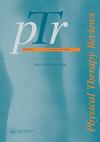An opportunity for transformative change in the US Healthcare System—cultural safety: a scoping review protocol
IF 0.8
Q4 REHABILITATION
引用次数: 0
Abstract
Abstract Objective We aim to collate and analyze current evidence for implementing cultural safety measures among patients, health professionals, in the education of health professionals, and within healthcare organizations. A second aim is to understand how to best assess the effectiveness of cultural safety interventions. Our third aim is to provide guidance on how culturally safe environments can be implemented in the US healthcare system. Introduction Culturally safe environments can improve health inequities among underrepresented groups. However, there is a paucity of evidence on how cultural safety can be implemented among patients, health professionals, in the education of health professionals, and within healthcare organizations in the United States (US). Inclusion criteria This scoping review will examine the US and international literature on cultural safety implemented by healthcare professionals and the experiences of their patients; educational interventions to improve cultural safety in health professional education; and the organization and systems-level initiatives that create culturally safe environments. Physician groups will not be included as power differentials between physician groups and patients are different from those among other health professionals and patients. Due to the wealth of experience and cultural safety literature in this area from countries outside of the US, international studies will be included. Methods This review will search national and international literature to inform cultural safety practices in the US and will be conducted in accordance with the JBI methodology and PRISMA-ScR extension. Key search sources will include CINAHL, MEDLINE, the Cochrane Library, PsycINFO, Social Work Abstracts, and GoogleScholar from 1988–2022. Reviewed sources will be in English and will include unpublished studies and grey literature. All sources will be reviewed by at least two independent reviewers, with a third independent reviewer to achieve consensus when necessary. Results will be presented in alignment with the four conceptual layers that create culturally safe environments: patients, health professionals, health professionals’ education, and healthcare organizations and systems. Dissemination This scoping review aims to collect, analyze, and disseminate an extensive overview of cultural safety in healthcare to inform guidance on how best to implement culturally safe healthcare and education for health professionals in the US.美国医疗体系变革的机会——文化安全:范围审查方案
本文章由计算机程序翻译,如有差异,请以英文原文为准。
求助全文
约1分钟内获得全文
求助全文
来源期刊

Physical Therapy Reviews
REHABILITATION-
CiteScore
1.30
自引率
0.00%
发文量
26
期刊介绍:
Physical Therapy Reviews is an international journal which aims to publish contemporary reviews, discussion papers and editorials within physical therapy, and in those basic and clinical sciences which are the basis of physical therapy. The journal is aimed at all those involved in research, teaching and practice within the area of physical therapy. Reviews (both descriptive and systematic) are invited in the following areas, which reflect the breadth and diversity of practice within physical therapy: •neurological rehabilitation •movement and exercise •orthopaedics and rheumatology •manual therapy and massage •sports medicine •measurement •chest physiotherapy •electrotherapeutics •obstetrics and gynaecology •complementary therapies •professional issues •musculoskeletal rehabilitation
 求助内容:
求助内容: 应助结果提醒方式:
应助结果提醒方式:


